Early Risk Warning of Highway Soft Rock Slope Group Using Fuzzy-Based Machine Learning
Abstract
:1. Introduction
2. Methods
2.1. The Establishment of a Soft Rock Slope Group
2.2. The Development of the Soft Rock Slope Risk Early-Warning Framework
3. Proposed Model
3.1. Risk Identification of an Individual Soft Rock Slope Using FNN
3.1.1. Establishment of the Risk Identification Index
3.1.2. Establishment of the Risk Levels of the Individual Soft Rock Slope
3.1.3. Establishment of FNN model
3.1.4. Model Training
3.1.5. Model Validation Using the Collected Soft Rock Slope Data
3.2. Early Risk Warning of a Soft Rock Slope Group Using the Comprehensive Evaluation Method Based on FNN
3.2.1. Establishment of the Early Risk-Warning Index
3.2.2. The Comprehensive Evaluation Method Based on FNN
3.2.3. Model Training and Output
4. Case Study
4.1. Dataset Collection and Preparation
4.2. Risk Identification of an Individual Soft Rock Slope Using FNN
4.2.1. Risk Identification Index
4.2.2. Model Training and Validation
4.2.3. Risk Identification Results and Discussion for Risk Identification of an Individual Soft Rock Slope Using FNN
4.3. Early Risk Warning of a Soft Rock Slope Group Using the Comprehensive Evaluation Method Based on FNN
4.3.1. Early Risk-Warning Index
4.3.2. Model Training
4.3.3. Early Risk-Warning Results for a Soft Rock Slope Group
4.3.4. Discussion
5. Conclusions
Author Contributions
Funding
Institutional Review Board Statement
Informed Consent Statement
Data Availability Statement
Acknowledgments
Conflicts of Interest
References
- Lee, D.-H.; Lai, M.-H.; Wu, J.-H.; Chi, Y.-Y.; Ko, W.-T.; Lee, B.-L. Slope management criteria for Alishan Highway based on database of heavy rainfall-induced slope failures. Eng. Geol. 2013, 162, 97–107. [Google Scholar] [CrossRef]
- Lai, J.; Zhang, L.; Duffield, C.F.; Aye, L. Engineering Reliability Analysis in Risk Management Framework: Development and Application in Infrastructure Project. Int. J. Appl. Math. 2013, 43, 242–249. [Google Scholar]
- Huabin, W.; Gangjun, L.; Weiya, X.; Gonghui, W. GIS-based landslide hazard assessment: An overview. Prog. Phys. Geog. 2005, 29, 548–567. [Google Scholar] [CrossRef]
- Goorchi, R.N.; Amini, M.; Memarian, H. A new rating system approach for risk analysis of rock slopes. Nat. Hazards 2018, 91, 75–102. [Google Scholar]
- Dang, K.; Sassa, K.; Konagai, K.; Karunawardena, A.; Bandara, R.M.S.; Hirota, K.; Tan, Q.; Ha, N.D. Recent rainfall-induced rapid and long-traveling landslide on 17 May 2016 in Aranayaka, Kagelle District, Sri Lanka. Landslides 2019, 16, 155–164. [Google Scholar] [CrossRef]
- Infante, D.; Di Martire, D.; Calcaterra, D.; Miele, P.; Scotto Di Santolo, A.; Ramondini, M. Integrated Procedure for Monitoring and Assessment of Linear Infrastructures Safety (I-Pro MONALISA) Affected by Slope Instability. Appl. Sci. 2019, 9, 5535. [Google Scholar] [CrossRef]
- Yin, C.; Li, H.; Hu, Z.; Li, Y. Application of the Terrestrial Laser Scanning in Slope Deformation Monitoring: Taking a Highway Slope as an Example. Appl. Sci. 2020, 10, 2808. [Google Scholar] [CrossRef]
- Zakaria, M.T.; Muztaza, N.M.; Zabidi, H.; Salleh, A.N.; Mahmud, N.; Samsudin, N.; Rosli, F.N.; Olugbenga, A.T.; Jia, T.Y. 2-D Cross-Plot Model Analysis Using Integrated Geophysical Methods for Landslides Assessment. Appl. Sci. 2021, 11, 747. [Google Scholar] [CrossRef]
- Liu, D.; Liu, C.; Tang, Y.; Gong, C. A GA-BP Neural Network Regression Model for Predicting Soil Moisture in Slope Ecological Protection. Sustainability 2022, 14, 1386. [Google Scholar] [CrossRef]
- Habumugisha, J.M.; Chen, N.; Rahman, M.; Islam, M.; Ahmad, H.; Elbeltagi, A.; Sharma, G.; Liza, S.N.; Dewan, A. Landslide Susceptibility Mapping with Deep Learning Algorithms. Sustainability 2022, 14, 1734. [Google Scholar] [CrossRef]
- Xiaojun, Z.; Gulishengmu, A.; Guang, Y.; Ping, G.; Chunxia, W.; Yi, L.; Xiaolong, L.; Pengfei, L.; Chenxi, L.; Changlu, Q.; et al. Evaluation of the Water Resource Carrying Capacity on the North Slope of the Tianshan Mountains, Northwest China. Sustainability 2022, 14, 1905. [Google Scholar]
- Gatto, M.P.A.; Montrasio, L. Analysis of the Behaviour of Very Slender Piles: Focus on the Ultimate Load. Int. J. Civ. Eng. 2021, 19, 145–153. [Google Scholar] [CrossRef]
- Gatto, M.P.A.; Montrasio, L.; Zavatto, L. Experimental Analysis and Theoretical Modelling of Polyurethane Effects on 1D Wave Propagation through Sand-Polyurethane Specimens. J. Earthq. Eng. 2021, 1–24. [Google Scholar] [CrossRef]
- Gatto, M.P.A.; Montrasio, L.; Berardengo, M.; Vanali, M. Experimental Analysis of the Effects of a Polyurethane Foam on Geotechnical Seismic Isolation. J. Earthq. Eng. 2020, 1–22. [Google Scholar] [CrossRef]
- Gatto, M.P.A.; Lentini, V.; Castelli, F.; Montrasio, L.; Grassi, D. The Use of Polyurethane Injection as a Geotechnical Seismic Isolation Method in Large-Scale Applications: A Numerical Study. Geosciences 2021, 11, 201. [Google Scholar] [CrossRef]
- Hua, X.; Fan, Q.; Shang, Y.; Cheng, J.; Zhang, Y.; Liu, Z. Application of coupling analysis method for slopes stability in three gorges reservoir region. Adv. Sci. Technol. Water Res. 2019, 39, 54–57. [Google Scholar]
- Cheng, Y.; Guo, T.; Qiu, C. Application of online safety monitoring system for high speed slope group in Guilong. Hunan Commun. Sci. Technol. 2019, 45, 37–42. [Google Scholar]
- Zhi, Z.; Jian, X.; Guangliang, Z. A review of slope risk analysis. Sichuan Cem. 2020, 8, 347–348. [Google Scholar]
- Raghuvanshi, T.K. Plane failure in rock slopes—A review on stability analysis techniques. J. King Saud Univ. Sci. 2019, 31, 101–109. [Google Scholar] [CrossRef]
- Hunter, A.G.M. A review of research into machine stability on slopes. Safety Sci. 1993, 16, 325–339. [Google Scholar] [CrossRef]
- Boggett, A.D.; Mapplebeck, N.J.; Cullen, R.J. South Shore Cliffs, Whitehaven—Geomorphological survey and emergency cliff stabilization works. Q. J. Eng. Geol. Hydroge. 2000, 33, 213–226. [Google Scholar] [CrossRef]
- Brand, E.W. Special Lecture: Landslide Risk Assessment in Hong Kong. In Proceedings of the International Symposium on Landslides, Lausanne, Switzerland, 10–15 July 1988; Volume 5, pp. 1059–1074. [Google Scholar]
- Gaprindashvili, G.; Van Westen, C.J. Generation of a national landslide hazard and risk map for the country of Georgia. Nat. Hazards 2016, 80, 69–101. [Google Scholar] [CrossRef]
- Harden, J.; Viberg, L. General report: Evaluation of landslide hazard. In Proceedings of the 5th International Symposium on Landslides, Lausanne, Switzerland, 10–15 July 1988; Volume 2, pp. 1037–1057. [Google Scholar]
- Lin, D.; Chen, P.; Ma, J.; Zhao, Y. Assessment of slope construction risk uncertainty based on index importance ranking. B Eng. Geol. Environ. 2019, 78, 4217–4228. [Google Scholar] [CrossRef]
- McDonnell, B.A. Hazard Identification and Visitor Risk Assessment at the Giant’s Causeway World Heritage Site, Ireland: Instability: Planning and Management; Thomas Telford Publishing: London, UK, 2002. [Google Scholar]
- Rautela, P.; Lakhera, R.C. Landslide risk analysis between Giri and Tons rivers in Himachal Himalaya (India). Int. J. Appl. Earth Obs. 2000, 2, 153–160. [Google Scholar] [CrossRef]
- Remondo, J.; Bonachea, J.; Cendrero, A. A statistical approach to landslide risk modelling at basin scale: From landslide susceptibility to quantitative risk assessment. Landslides 2005, 2, 321–328. [Google Scholar] [CrossRef]
- Liu, S.Y.; Shao, L.T.; Li, H.J. Slope stability analysis using the limit equilibrium method and two finite element methods. Comput. Geotech. 2015, 63, 291–298. [Google Scholar] [CrossRef]
- Huang, Y.H. Slope Stability Analysis by the Limit Equilibrium Method: Fundamentals and Methods; American Society of Civil Engineers: Reston, VA, USA, 2014. [Google Scholar]
- Kalatehjari, R.; Ali, N. A Review of Three-Dimensional Slope Stability Analyses based on Limit Equilibrium Method. Electron. J. Geotech. Eng. 2013, 18, 119–134. [Google Scholar]
- Bednarik, M.; Yilmaz, I.; Marschalko, M. Landslide hazard and risk assessment: A case study from the Hlohovec-Sered’ landslide area in south-west Slovakia. Nat. Hazards 2012, 64, 547–575. [Google Scholar] [CrossRef]
- Dai, F.C.; Lee, C.F. Landslide characteristics and slope instability modeling using GIS, Lantau Island, Hong Kong. Geomorphol. 2002, 42, 213–228. [Google Scholar] [CrossRef]
- McQuillan, A.; Canbulat, I.; Payne, D.; Oh, J. New risk assessment methodology for coal mine excavated slopes. Int. J. Min. Sci. Technol. 2018, 28, 583–592. [Google Scholar] [CrossRef]
- Li, D.Q.; Yang, Z.Y.; Cao, Z.J.; Zhang, L.M. Area failure probability method for slope system failure risk assessment. Comput. Geotech. 2019, 107, 36–44. [Google Scholar] [CrossRef]
- Drummond, C. Machine learning as an experimental science (revisited). In AAAI Workshop on Evaluation Methods for Machine Learning; AAAI Press: Menlo Park, CA, USA, 2006; pp. 1–5. [Google Scholar]
- Koopialipoor, M.; Armaghani, D.J.; Yang, H.; Gordan, B.; Khorami, M.; Tahir, M.M. Intelligent design of retaining wall structures under dynamic conditions. Steel Compos. Struct Int. J. 2019, 31, 629–640. [Google Scholar]
- Ma, Z.; Mei, G.; Piccialli, F. Machine learning for landslides prevention: A survey. Neural Comp. Appl. 2021, 33, 10881–10907. [Google Scholar] [CrossRef]
- Cai, M.; Koopialipoor, M.; Armaghani, D.J.; Pham, B.T. Evaluating slope deformation of earth dams due to earthquake shaking using MARS and GMDH techniques. Appl. Sci. 2020, 10, 1486. [Google Scholar] [CrossRef]
- Momeni, E.; Yarivand, A.; Dowlatshahi, M.B.; Armaghani, D.J. An efficient optimal neural network based on gravitational search algorithm in predicting the deformation of geogrid-reinforced soil structures. Transp. Geotech. 2021, 26, 100446. [Google Scholar] [CrossRef]
- Xu, C.; Gordan, B.; Koopialipoor, M.; Armaghani, D.J.; Tahir, M.M. Improving performance of retaining walls under dynamic conditions developing an optimized ANN based on ant colony optimization technique. IEEE Access 2019, 7, 94692–94700. [Google Scholar] [CrossRef]
- Huat, C.Y.; Moosavi, S.M.H.; Mohammed, A.S.; Armaghami, D.J.; Ulrikh, D.V.; Monjezi, M.; Lai, S.H. Factors Influencing Pile Friction Bearing Capacity: Proposing a Novel Procedure Based on Gradient Boosted Tree Technique. Sustainability 2021, 13, 11862. [Google Scholar] [CrossRef]
- Pradhan, B.; Lee, S. Landslide risk analysis using artificial neural network model focussing on different training sites. Int. J. Phys. Sci. 2009, 4, 1–15. [Google Scholar]
- Koopialipoor, M.; Armaghani, D.J.; Hedayat, A.; Marto, A.; Gordan, B. Applying various hybrid intelligent systems to evaluate and predict slope stability under static and dynamic conditions. Soft Comp. 2019, 23, 5913–5929. [Google Scholar] [CrossRef]
- Asteris, P.G.; Rizal, F.I.M.; Koopialipoor, M.; Roussis, P.C.; Ferentinou, M.; Armaghani, D.J.; Gordan, B. Slope Stability Classification under Seismic Conditions Using Several Tree-Based Intelligent Techniques. Appl. Sci. 2022, 12, 1753. [Google Scholar] [CrossRef]
- Chen, H.; Asteris, P.G.; Armaghani, D.J.; Gordan, B.; Pham, B.T. Assessing dynamic conditions of the retaining wall: Developing two hybrid intelligent models. Appl. Sci. 2019, 9, 1042. [Google Scholar] [CrossRef]
- Xiong, J.; Sun, M.; Zhang, H. Application of the Levenburg–Marquardt back propagation neural network approach for landslide risk assessments. Nat. Hazards Earth Syst. Sci. 2019, 19, 629–653. [Google Scholar] [CrossRef]
- Kanungo, D.P.; Arora, M.; Gupta, R.P.; Sarkar, S. Landslide risk assessment using concepts of danger pixels and fuzzy set theory in Darjeeling Himalayas. Landslides 2008, 5, 407–416. [Google Scholar] [CrossRef]
- Leonardi, G.; Palamara, R.; Suraci, F. A fuzzy methodology to evaluate the landslide risk in road lifelines. Transp. Res. Procedia 2020, 45, 732–739. [Google Scholar] [CrossRef]
- Zhou, N.; Fu, H.; Yuan, Y. Evaluation approach of slope stability based on fuzzy neural network. Chin. J. Undergr. Space Eng. 2009, 5, 1826–1832. [Google Scholar]
- Li, Y. Researches on Comprehensive Evaluation Method Based on Fuzzy Neural Network; Southwest University: Chongqing, China, 2005. [Google Scholar]
- Zhang, G. Coupled stability analysis for slopes near a reservoir. Geofluids 2015, 55, 612–615. [Google Scholar]
- Li, X.; Kong, J. Runout Distance Estimation of Landslides Triggered by “5·12” Wenchuan Earthquake. J. Sichuan Univ. Eng. Sci. Ed. 2010, 42, 243–249. [Google Scholar]
- Feng, X.; Wang, Y.; Lu, S. Neural network estimation of slope stability. J. Eng. Geol. 1995, 419, 54–61. [Google Scholar]
- Ying, H.; Siler, W.; Buckley, J.J. Fuzzy control theory A nonlinear case. Automatica 1990, 26, 513–520. [Google Scholar] [CrossRef]
- Anderson, C.W. Learning to Control an Inverted Pendulum Using Neural Networks. IEEE Contr. Syst. Mag. 1989, 9, 31–37. [Google Scholar] [CrossRef]
- Beieniawski, Z.T. The geomechanics classification in rock engineering applications. In Proceedings of the 4th International Congress on Rock Mechanics (ISRM) Congress, Montreux, Switzerland, 2–8 September 1979; International Society for Rock Mechanics and Rock Engineering: Lisbon, Portugal, 1979. [Google Scholar]
- Romana, M. SMR classification. In Proceedings of the 7th ISRM International Congress in Rock Mechanics, Aachen, Germany, 16–20 September 1991; International Society for Rock Mechanics (ISRM): Lisbon, Portugal, 1992; pp. 78–84. [Google Scholar]
- Huang, W.; Du, J.; Sun, H.; Zhou, C.; Liu, Z.; Zhang, L. New polymer composites improve silty clay soil microstructure: An evaluation using NMR. Land Degrad. Dev. 2021, 32, 3272–3281. [Google Scholar] [CrossRef]
- Liu, Z.; Liu, P.; Zhou, C.; Huang, Y.; Zhang, L. Structural Health Monitoring of Underground Structures in Reclamation Area Using Fiber Bragg Grating Sensors. Sensors 2019, 19, 2849. [Google Scholar] [CrossRef] [PubMed]
- GB 50330-2013; Technical Code for Building Slope Engineering. China Building Industry Press: Beijing, China, 2013.
- Liu, R.; Wang, Y. Comprehensive grade evaluation of power quality based on improved radar chart method and Gaussian membership degree. Elec. Measurement Instrum. 2018, 55, 69–74. [Google Scholar]
- Zhou, C.; Ouyang, J.; Ming, W.; Zhang, G.; Du, Z.; Liu, Z. A Stratigraphic Prediction Method Based on Machine Learning. Appl. Sci. 2019, 9, 3553. [Google Scholar] [CrossRef]
- CHELBI Engineering Consultants. Detailed Engineering Geological Survey Report of the 10th Contract Section of the Highway from Huacheng to Lankou Section of the Highway; CHELBI Engineering Consultants: Beijing, China, 2005. [Google Scholar]
- China Planning Press. Standard for Test Methods of Engineering Rock Mass; China Planning Press: Beijing, China, 2013. [Google Scholar]
- A Study on Rainfall in Meizhou River Source Area in 2005. National Weather Service Website. Available online: http://www.cma.gov.cn/ (accessed on 30 July 2005).
- Ministry of Railways. Monitoring Report of High Slope Engineering in the Section from Chengjiang to Lankou of Mei (Zhou) River (Source) Expressway; Shenzhen Research and Design Institute of Science Research Institute, Ministry of Railways: Shenzhen, China, 2005.
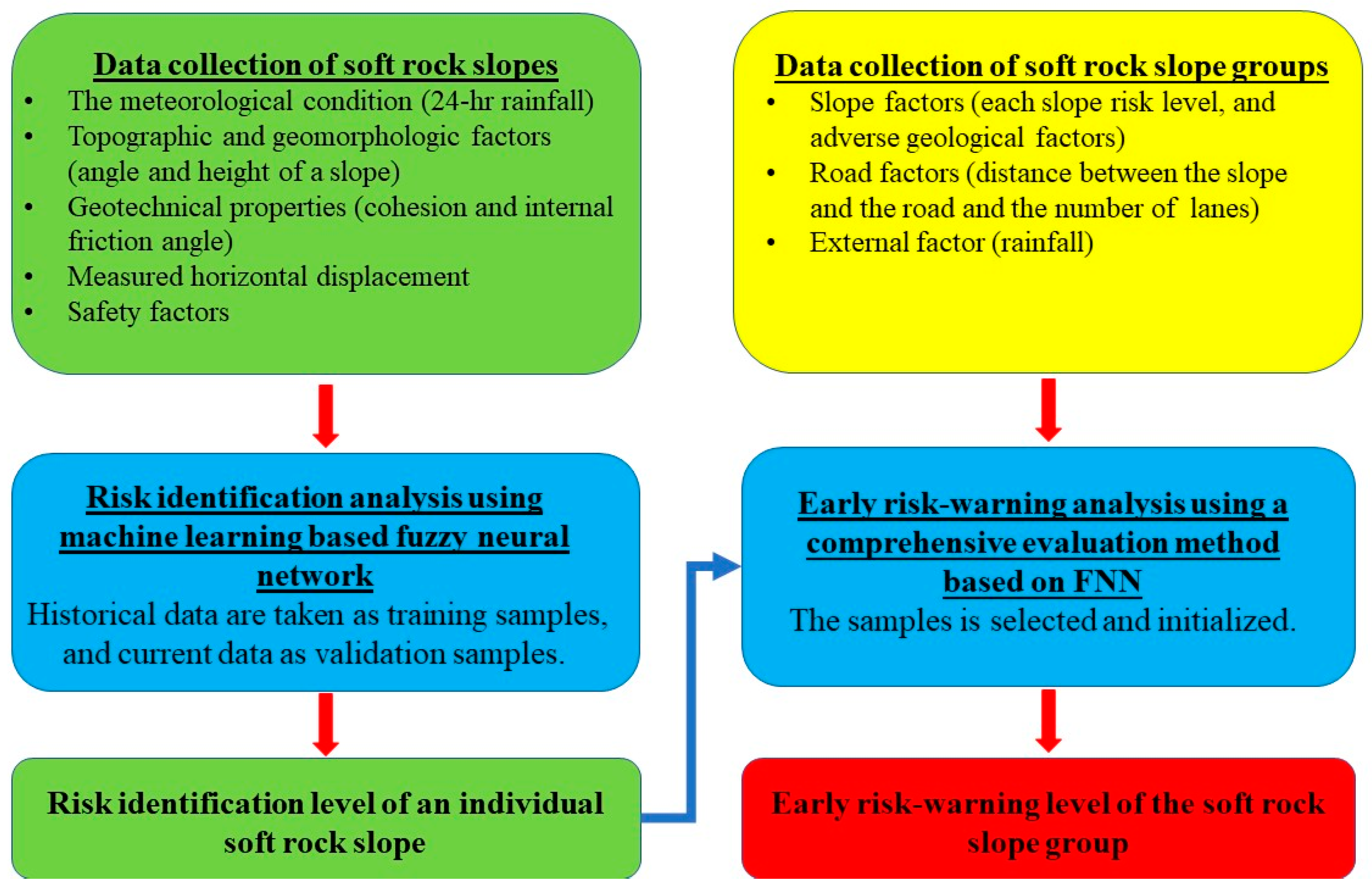
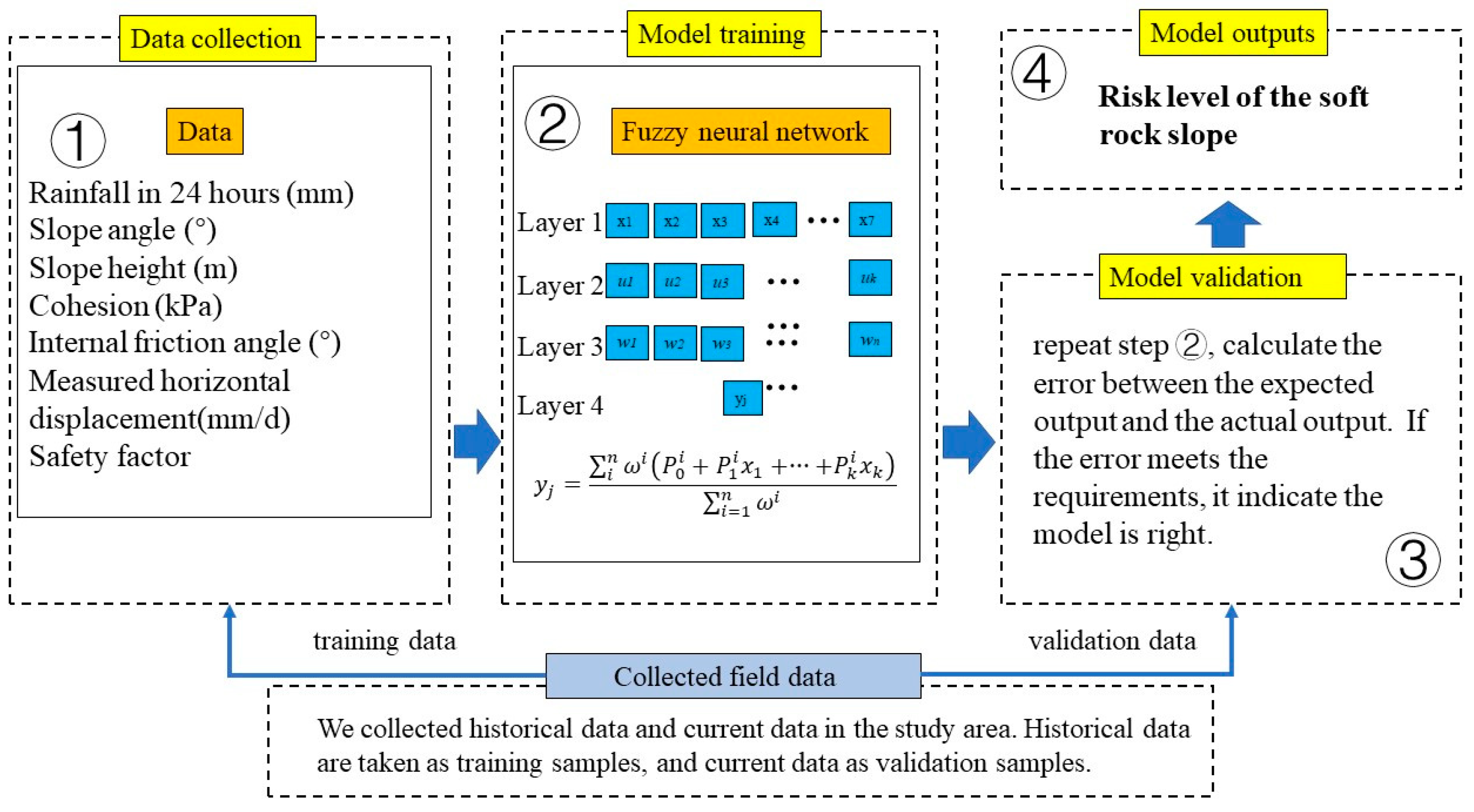
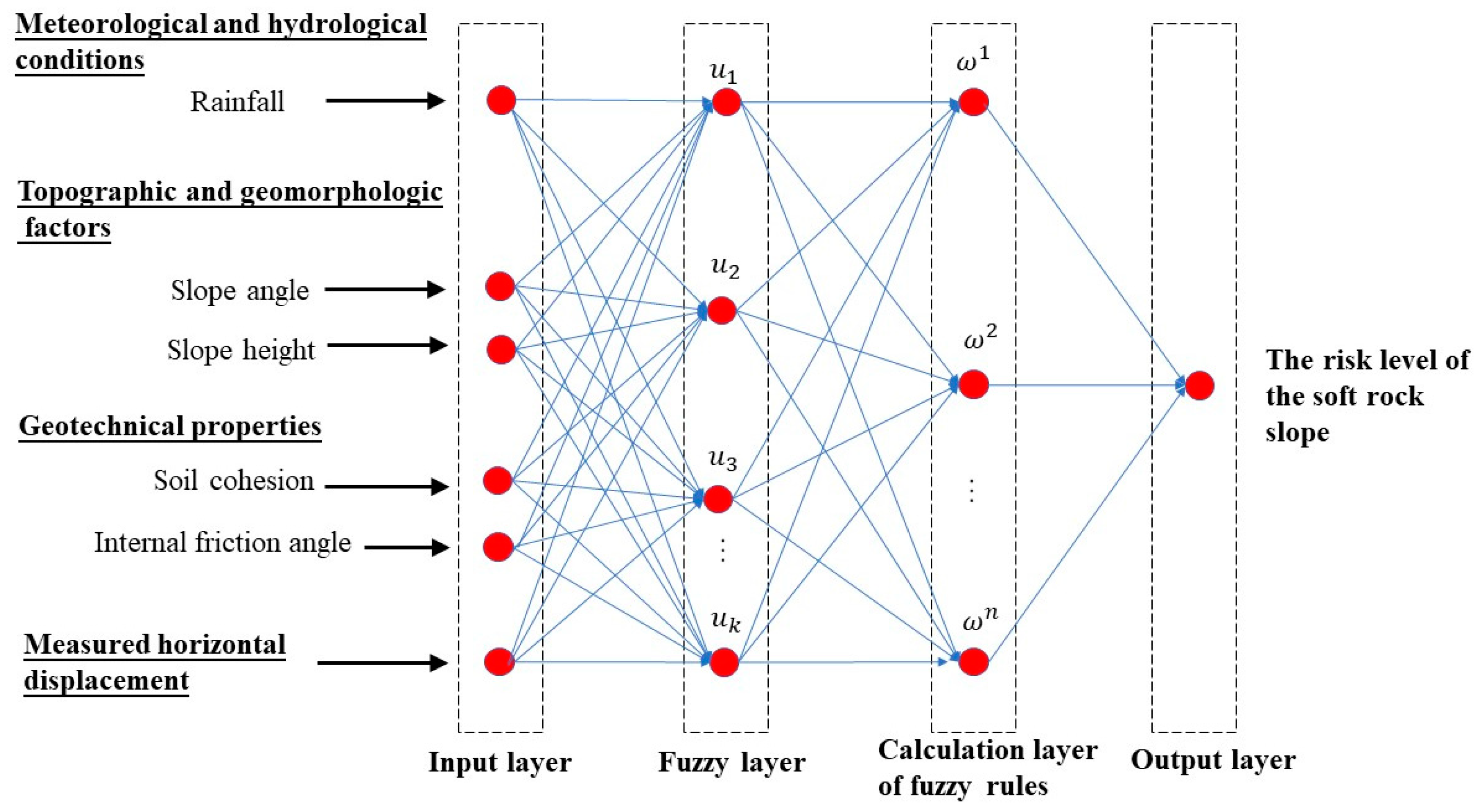
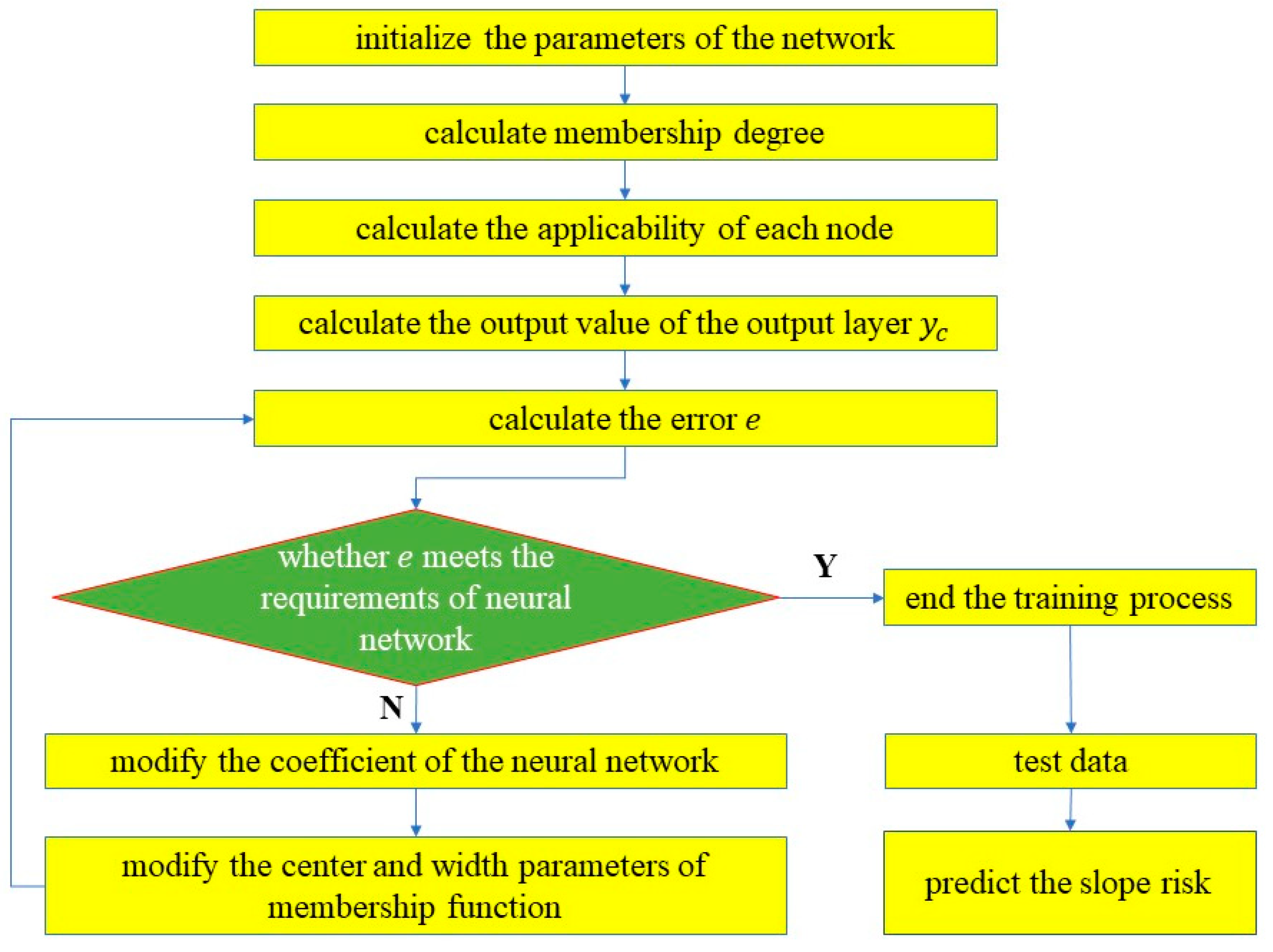

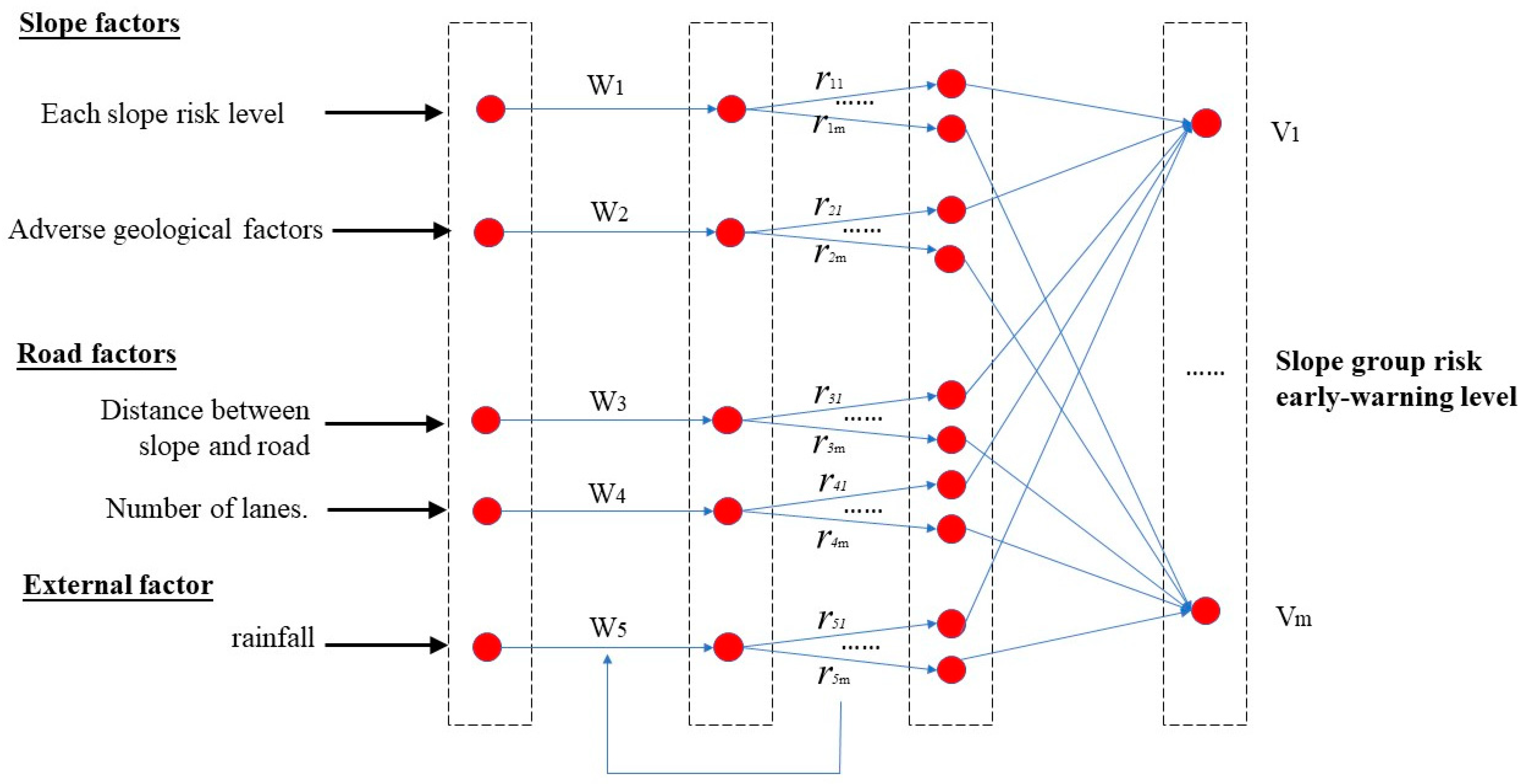




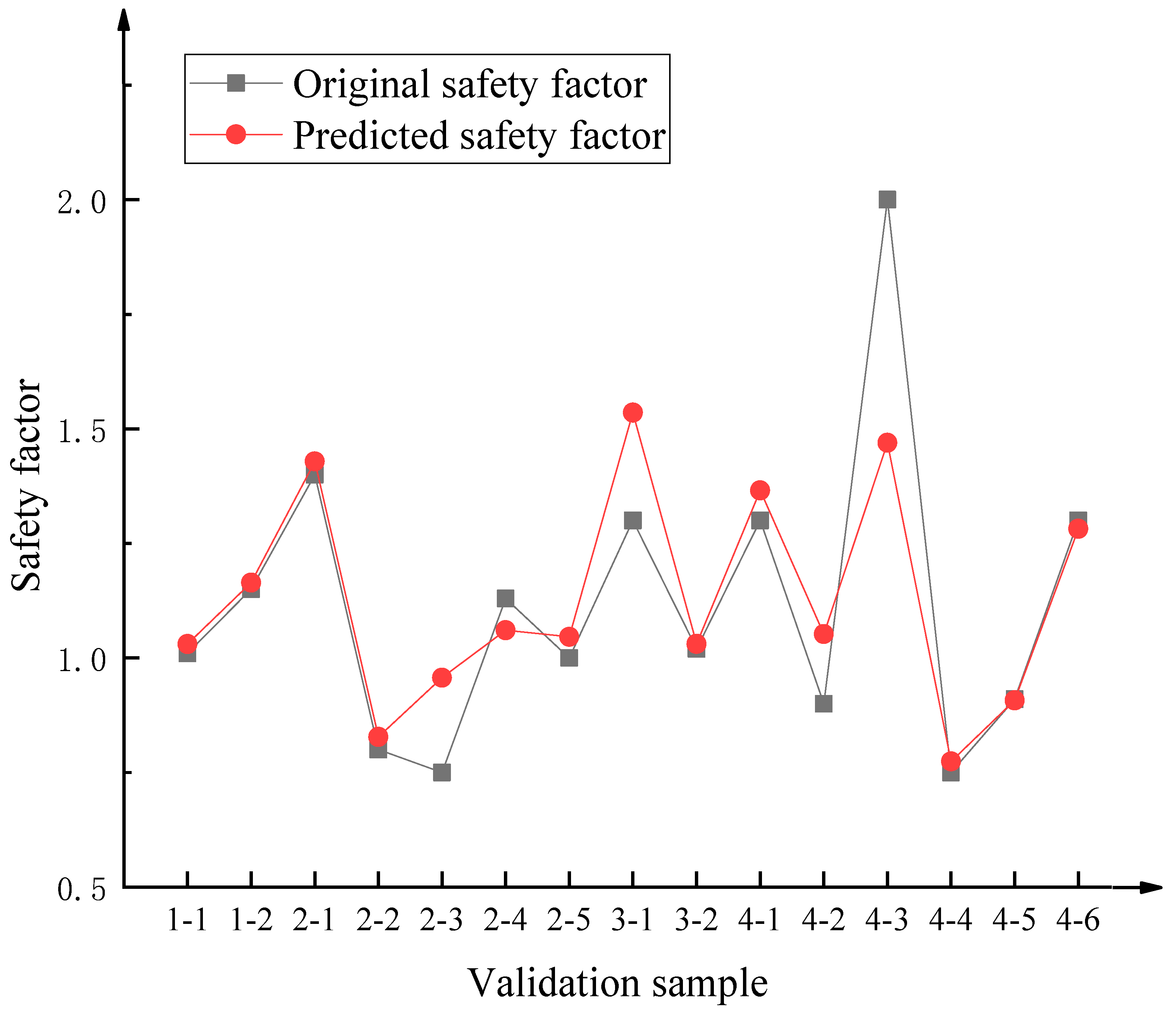
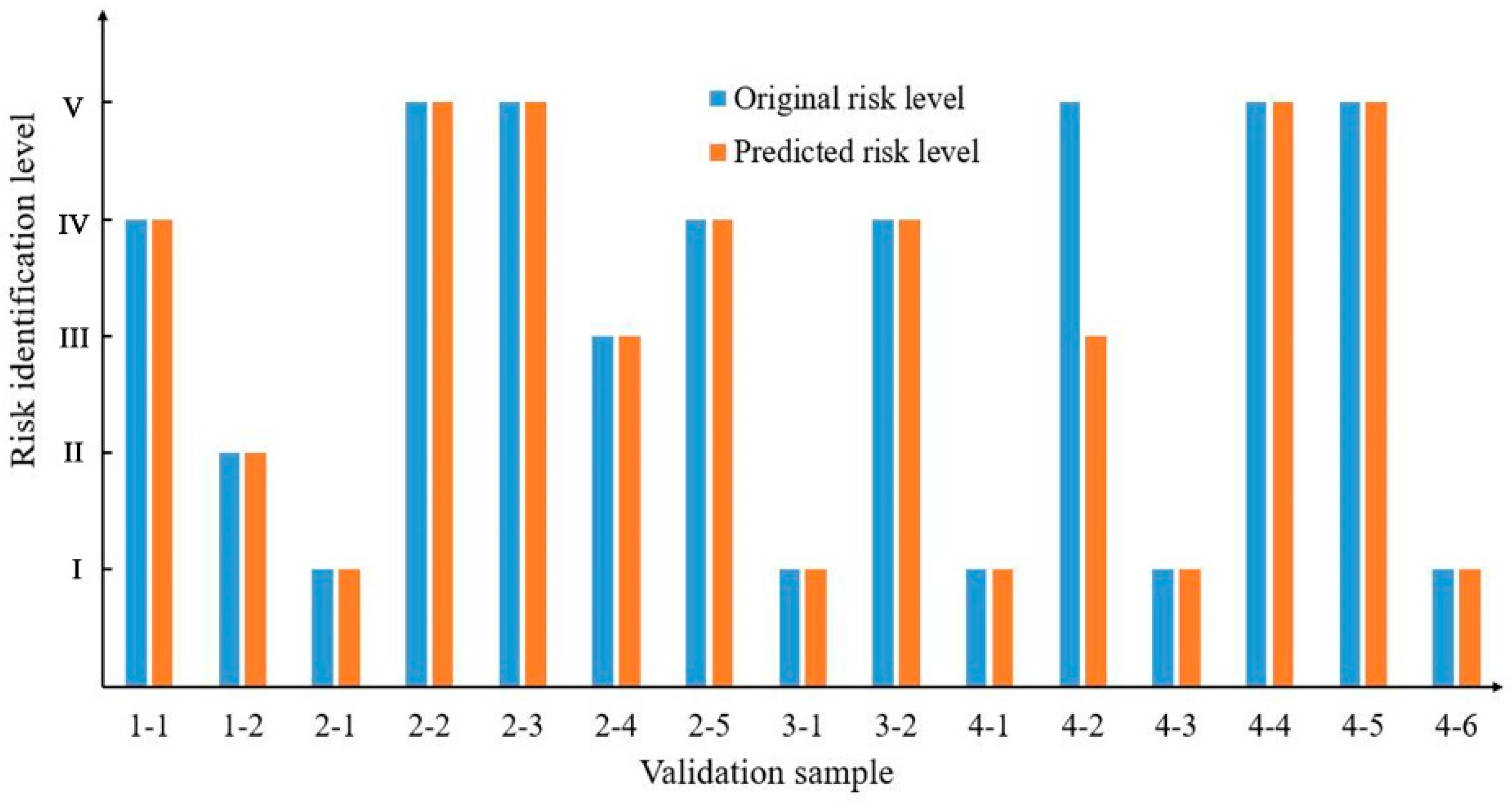
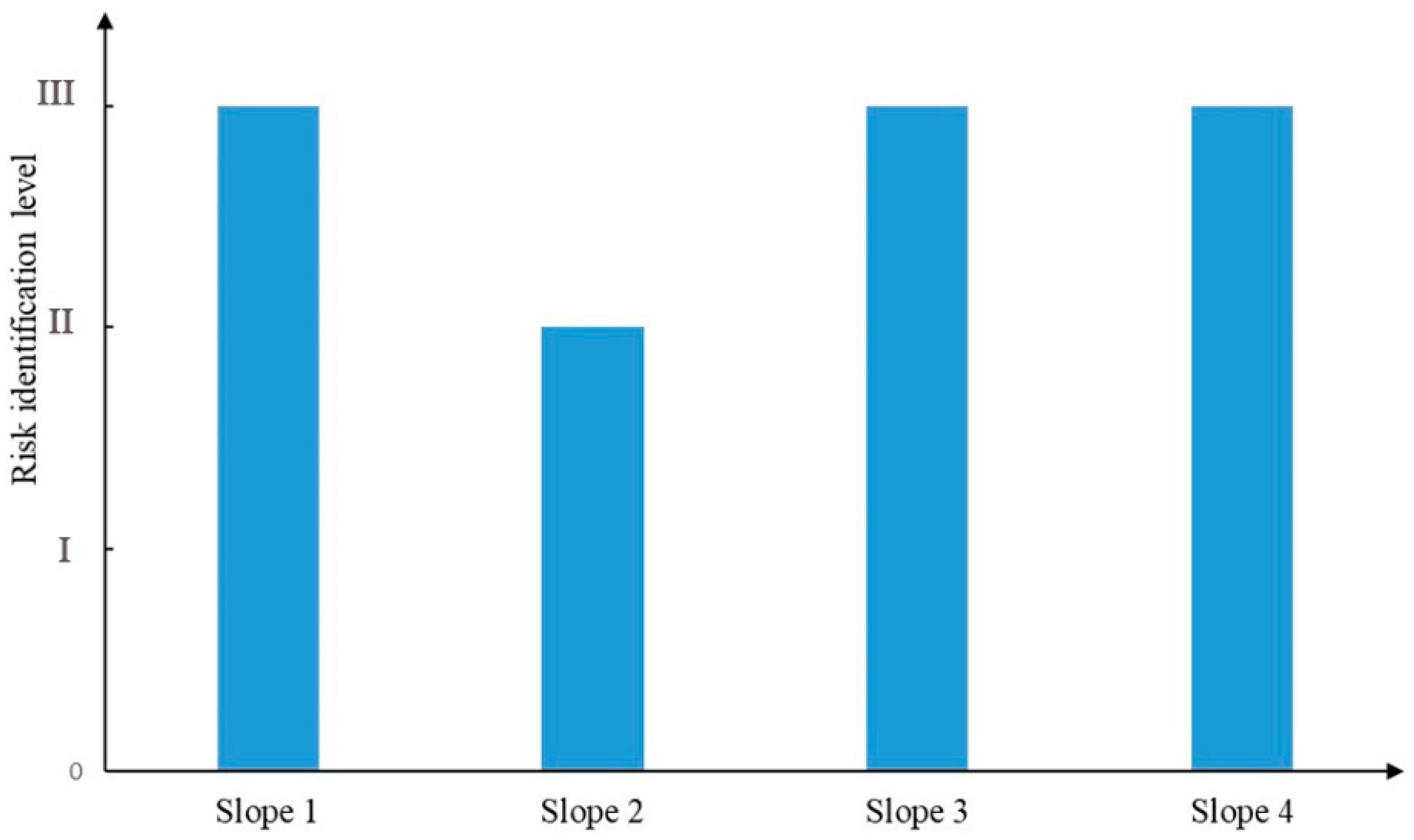
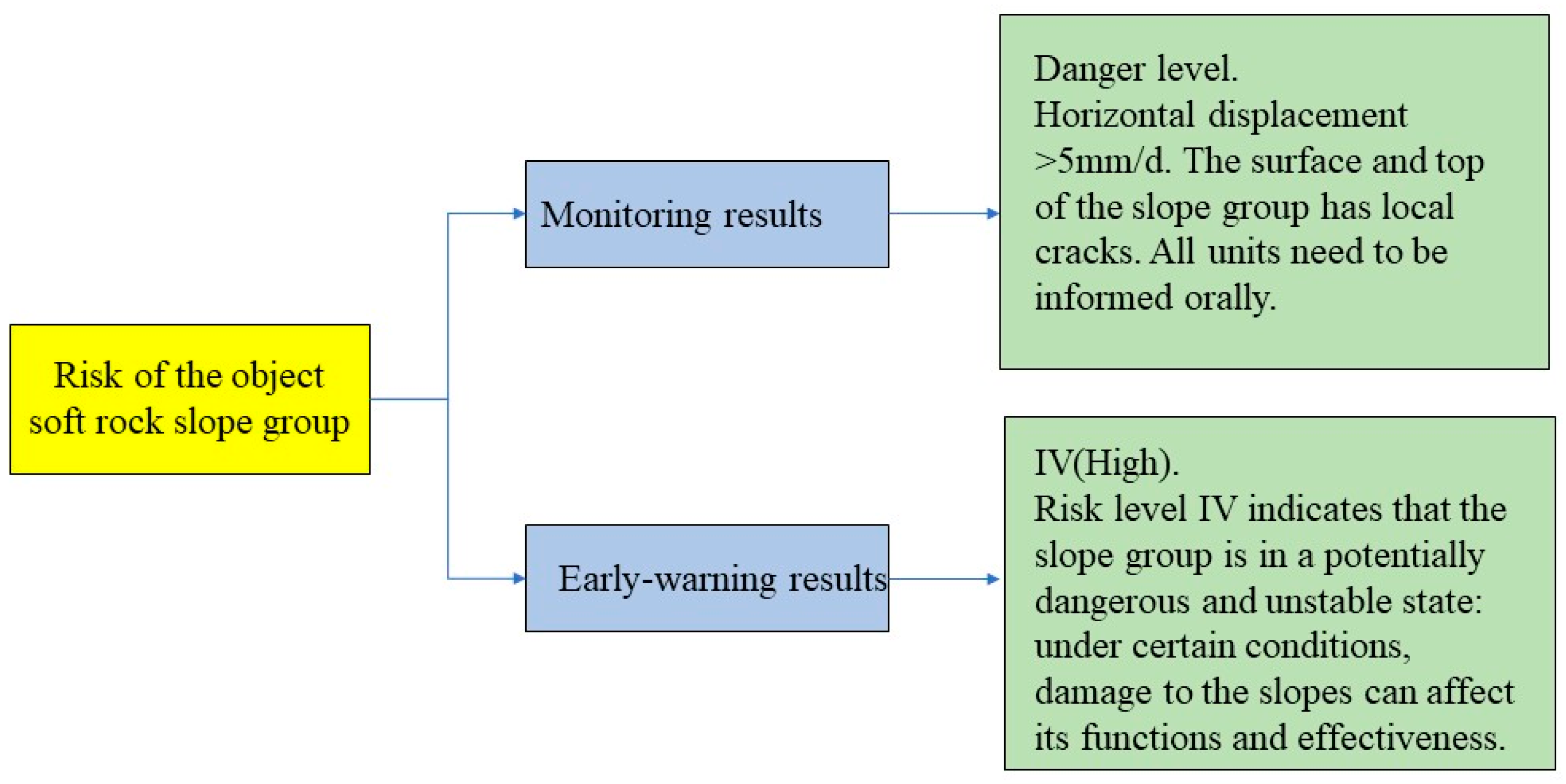
| Level of Risk | I (Negligible) | II (Minor) | III (Mild) | IV (Major) | V (Severe) |
|---|---|---|---|---|---|
| Safety factor | >1.25 | 1.15–1.25 | 1.05–1.15 | 1.0–1.05 | ≤1.0 |
| Factors | I | II | III | IV | V | |
|---|---|---|---|---|---|---|
| Soft rock slope factor | Each soft rock slope risk level | 1 | 2 | 3 | 4 | 5 |
| Adverse geological condition | Weaker (0.1) | Weak (0.3) | Average (0.5) | Strong (0.7) | Stronger (0.9) | |
| Road factor | Distance between soft rock slope and road(m) | >30 | 30–22.5 | 22.5–15 | 15–7.5 | <7.5 |
| Number of lanes | ≥8 | 6 | 4 | 2 | 1 | |
| External factor | Rainfall | Grading parameters need to be determined | ||||
| Soft Rock Slope | Depth Range | Stratum | Figures |
|---|---|---|---|
| Slope 1 | From the surface to 2.8 m underground | Mild clay |  |
| From 2.8 m underground to 5.5 m underground | Strongly weathering mixed gneiss | 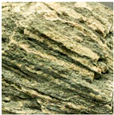 | |
| From the 5.5 m underground to 29.0 m underground | Weak weathering mixed gneiss | ||
| Slope 2 | From the surface to 4.5 m underground | Mild clay |  |
| From 4.5 m underground to 18.5 m underground | Completely weathering mixed gneiss |  | |
| From 18.5 m underground to 41.5 m underground | Strongly weathered mixed gneiss | ||
| From 41.5 m underground to 49.0 m underground | Moderate weathering mixed gneiss | ||
| Slope 3 | From the surface to 4.0 m underground | Mild clay |  |
| From 4.0 m underground to 10.3 m underground | Completely weathering mixed gneiss | 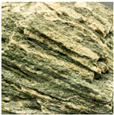 | |
| From 10.3 m underground to 21.3 m underground | Strongly weathered mixed gneiss | ||
| From 21.3 m underground to 27.1 m underground | Metamorphic sandstone | 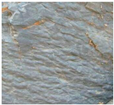 | |
| Slope 4 | From the surface to 2.0 m underground | Mild clay |  |
| From 2.0 m underground to 4.6 m underground | Completely weathering siltstone |  | |
| From 4.6 m underground to 24.8 m underground | Strongly weathering siltstone |
| Number | Soft Rock Slope Angle (°) | Soft Rock Slope Height (m) | Friction Angle (°) | Weight (kN/m3) | Cohesion (KPa) | 24-h Rainfall (mm) | Measured Horizontal Displacement (mm/d) | Safety Factors |
|---|---|---|---|---|---|---|---|---|
| 1 | 43.0 | 420.0 | 35.0 | 27.0 | 40.0 | 41 | 5 | 1.15 |
| 2 | 47.1 | 292.0 | 35.0 | 27.0 | 40.0 | 42 | 4 | 1.15 |
| 3 | 42.6 | 301.0 | 33.0 | 27.0 | 32.0 | 36 | 4 | 1.16 |
| 4 | 47.0 | 213.0 | 37.0 | 31.3 | 68.0 | 34 | 1 | 1.20 |
| 5 | 49.0 | 200.5 | 37.0 | 31.3 | 68.0 | 36 | 2 | 1.20 |
| 6 | 46.0 | 366.0 | 37.0 | 31.3 | 68.0 | 34 | 3 | 1.20 |
| 7 | 47.0 | 305.0 | 37.0 | 31.3 | 68.6 | 37 | 3 | 1.20 |
| 8 | 46.0 | 432.0 | 35.0 | 25.0 | 46.0 | 40 | 2 | 1.23 |
| 9 | 37.8 | 320.0 | 35.0 | 27.0 | 37.5 | 30 | 1 | 1.24 |
| 10 | 41.0 | 135.0 | 29.7 | 27.3 | 31.5 | 27 | 1 | 1.25 |
| 11 | 50.0 | 92.0 | 31.0 | 27.3 | 26.0 | 34 | 2 | 1.25 |
| 12 | 41.0 | 110.0 | 31.0 | 27.3 | 14.0 | 26 | 1 | 1.25 |
| 13 | 50.0 | 90.5 | 28.0 | 27.3 | 16.8 | 27 | 3 | 1.25 |
| 14 | 42.0 | 359.0 | 35.0 | 27.0 | 35.0 | 36 | 1 | 1.27 |
| 15 | 47.0 | 443.0 | 35.0 | 25.0 | 46.0 | 31 | 2 | 1.28 |
| 16 | 42.4 | 289.0 | 33.0 | 27.0 | 32.0 | 31 | 1 | 1.30 |
| 17 | 46.0 | 393.0 | 35.0 | 25.0 | 46.0 | 33 | 1 | 1.31 |
| 18 | 50.0 | 284.0 | 35.0 | 25.0 | 46.0 | 34 | 2 | 1.34 |
| 19 | 41.0 | 511.0 | 39.0 | 27.3 | 10.0 | 16 | 2 | 1.43 |
| 20 | 44.0 | 435.0 | 35.0 | 25.0 | 46.0 | 24 | 1 | 1.37 |
| 21 | 40.0 | 470.0 | 39.0 | 27.3 | 10.0 | 23 | 1 | 1.42 |
| 22 | 42.0 | 407.0 | 40.0 | 27.0 | 50.0 | 29 | 1 | 1.44 |
| 23 | 40.0 | 480.0 | 39.0 | 27.3 | 10.0 | 32 | 3 | 1.45 |
| 24 | 49.0 | 330.0 | 40.0 | 25.0 | 48.0 | 34 | 2 | 1.49 |
| 25 | 45.5 | 299.0 | 36.0 | 25.0 | 55.0 | 22 | 2 | 1.52 |
| 26 | 44.5 | 299.0 | 36.0 | 25.0 | 55.0 | 26 | 1 | 1.55 |
| 27 | 30.0 | 88.0 | 26.0 | 14.0 | 12.0 | 46 | 5 | 0.63 |
| 28 | 45.0 | 50.0 | 36.0 | 20.0 | 0.0 | 52 | 6 | 0.67 |
| 29 | 30.0 | 6.0 | 0.0 | 18.5 | 12.0 | 56 | 5 | 0.78 |
| 30 | 45.0 | 50.0 | 36.0 | 20.0 | 0.0 | 54 | 4 | 0.79 |
| 31 | 45.0 | 50.0 | 36.0 | 20.0 | 20.0 | 52 | 4 | 0.83 |
| 32 | 45.0 | 8.0 | 30.0 | 12.0 | 0.0 | 61 | 4 | 0.80 |
| 33 | 45.0 | 50.0 | 36.0 | 22.0 | 0.0 | 57 | 5 | 0.89 |
| 34 | 45.0 | 10.0 | 35.0 | 22.4 | 10.0 | 56 | 5 | 0.90 |
| 35 | 45.0 | 50.0 | 36.0 | 20.0 | 20.0 | 63 | 4 | 0.96 |
| 36 | 30.0 | 3.7 | 0.0 | 16.5 | 11.5 | 61 | 4 | 1.00 |
| 37 | 31.0 | 76.8 | 30.0 | 21.5 | 6.9 | 54 | 3 | 1.01 |
| 38 | 45.0 | 50.0 | 36.0 | 22.0 | 20.0 | 57 | 4 | 1.02 |
| 39 | 30.0 | 88.0 | 26.0 | 14.0 | 12.0 | 56 | 3 | 1.02 |
| 40 | 28.0 | 12.8 | 32.0 | 21.8 | 8.6 | 42 | 2 | 1.03 |
| 41 | 20.0 | 61.0 | 20.0 | 21.4 | 0.0 | 46 | 2 | 1.03 |
| 42 | 20.0 | 7.6 | 20.0 | 18.8 | 0.0 | 51 | 3 | 1.05 |
| 43 | 37.0 | 214.0 | 32.0 | 23.5 | 0.0 | 46 | 3 | 1.08 |
| 44 | 30.0 | 6.0 | 0.0 | 18.5 | 25.0 | 42 | 2 | 1.09 |
| 45 | 35.0 | 21.0 | 28.0 | 19.1 | 11.7 | 46 | 3 | 1.09 |
| 46 | 40.0 | 115.0 | 20.0 | 16.0 | 70.0 | 59 | 2 | 1.11 |
| 47 | 20.0 | 30.5 | 25.0 | 18.8 | 14.4 | 41 | 1 | 1.11 |
| 48 | 35.0 | 8.2 | 15.0 | 18.7 | 26.3 | 42 | 1 | 1.11 |
| 49 | 45.0 | 20.0 | 30.2 | 18.0 | 24.0 | 46 | 2 | 1.12 |
| 50 | 20.0 | 50.0 | 17.0 | 14.8 | 0.0 | 46 | 1 | 1.13 |
| 51 | 20.0 | 100.0 | 20.0 | 23.0 | 0.0 | 37 | 2 | 1.20 |
| 52 | 50.0 | 200.0 | 45.0 | 26.0 | 150.0 | 38 | 2 | 1.20 |
| 53 | 30.0 | 40.0 | 26.5 | 20.6 | 16.3 | 35 | 3 | 1.25 |
| 54 | 53.0 | 120.0 | 45.0 | 25.0 | 120.0 | 32 | 2 | 1.30 |
| 55 | 20.0 | 8.0 | 24.5 | 20.0 | 0.0 | 35 | 2 | 1.37 |
| 56 | 22.0 | 10.7 | 13.0 | 20.4 | 24.9 | 42 | 2 | 1.40 |
| 57 | 35.0 | 4.0 | 30.0 | 12.0 | 0.0 | 35 | 1 | 1.44 |
| 58 | 33.0 | 8.0 | 40.0 | 22.0 | 0.0 | 26 | 1 | 1.45 |
| 59 | 35.0 | 4.0 | 30.0 | 12.0 | 0.0 | 25 | 2 | 1.46 |
| 60 | 33.0 | 8.0 | 40.0 | 24.0 | 0.0 | 22 | 1 | 1.58 |
| 61 | 25.0 | 10.7 | 30.0 | 18.8 | 15.3 | 20 | 1 | 1.63 |
| 62 | 30.0 | 20.0 | 30.3 | 21.4 | 10.0 | 19 | 1 | 1.70 |
| 63 | 35.0 | 100.0 | 35.0 | 28.4 | 29.4 | 14 | 2 | 1.78 |
| 64 | 45.0 | 15.0 | 45.0 | 22.4 | 100.0 | 13 | 1 | 1.80 |
| 65 | 20.0 | 30.5 | 25.0 | 18.8 | 14.4 | 18 | 1 | 1.88 |
| 66 | 35.0 | 100.0 | 38.0 | 28.4 | 39.2 | 12 | 3 | 1.99 |
| 67 | 30.0 | 10.0 | 35.0 | 22.4 | 10.0 | 10 | 1 | 2.00 |
| 68 | 20.0 | 30.5 | 20.0 | 18.8 | 57.5 | 10 | 1 | 2.05 |
| 69 | 20.0 | 8.0 | 30.0 | 18.0 | 5.0 | 10 | 1 | 2.05 |
| 70 | 35.0 | 8.0 | 30.0 | 12.0 | 0.0 | 67 | 4 | 0.86 |
| 71 | 45.0 | 50.0 | 36.0 | 20.0 | 20.0 | 64 | 2 | 0.96 |
| 72 | 47.0 | 117.0 | 30.0 | 27.0 | 320.0 | 29 | 2 | 1.61 |
| 73 | 38.0 | 140.0 | 30.0 | 27.0 | 320.0 | 25 | 2 | 1.71 |
| 74 | 37.0 | 128.0 | 30.0 | 27.0 | 320.0 | 24 | 1 | 1.81 |
| 75 | 44.0 | 120.0 | 40.7 | 28.0 | 328.0 | 23 | 1 | 1.89 |
| 76 | 44.0 | 116.0 | 40.7 | 28.0 | 328.0 | 26 | 3 | 1.98 |
| 77 | 43.0 | 166.0 | 36.8 | 27.0 | 242.5 | 34 | 1 | 1.60 |
| 78 | 38.0 | 121.0 | 36.0 | 26.3 | 162.1 | 31 | 1 | 1.69 |
| 79 | 45.0 | 206.0 | 41.0 | 27.0 | 340.0 | 26 | 2 | 1.80 |
| 80 | 40.0 | 186.0 | 40.0 | 27.0 | 305.0 | 25 | 1 | 1.89 |
| Soft Rock Slope | Number | Soft Rock Slope Angle (°) | Soft Rock Slope Height (m) | Friction Angle (°) | Weight (kN/m3) | Cohesion (KPa) | 24-h Rainfall (mm) | Measured Horizontal Displacement (mm/d) | Safety Factors |
|---|---|---|---|---|---|---|---|---|---|
| slope 1 | 1-1 | 22.0 | 25.0 | 17.5 | 27.3 | 14.6 | 68 | 3 | 1.01 |
| 1-2 | 20.0 | 35.0 | 21.3 | 21.0 | 13.7 | 45 | 2 | 1.15 | |
| slope 2 | 2-1 | 25.0 | 20.0 | 24.1 | 27.0 | 10.9 | 39 | 1 | 1.40 |
| 2-2 | 26.0 | 48.0 | 23.6 | 18.4 | 16.1 | 75 | 5 | 0.80 | |
| 2-3 | 25.0 | 110.0 | 12.0 | 19.5 | 11.8 | 59 | 5 | 0.75 | |
| 2-4 | 25.0 | 55.0 | 26.4 | 25.3 | 28.1 | 39 | 2 | 1.13 | |
| 2-5 | 25.0 | 20.0 | 24.1 | 19.5 | 10.9 | 57 | 5 | 1.00 | |
| slope 3 | 3-1 | 55.0 | 20.0 | 33.7 | 25.0 | 41.3 | 29 | 1 | 1.30 |
| 3-2 | 50.0 | 40.0 | 27.2 | 20.1 | 20.4 | 42 | 5 | 1.02 | |
| slope 4 | 4-1 | 35.0 | 40.0 | 21.4 | 20.0 | 22.8 | 28 | 2 | 1.30 |
| 4-2 | 30.0 | 45.0 | 18.6 | 20.3 | 16.6 | 56 | 4 | 0.90 | |
| 4-3 | 33.0 | 78.0 | 21.0 | 31.0 | 65.0 | 26 | 1 | 2.00 | |
| 4-4 | 33.0 | 78.0 | 15.0 | 22.5 | 10.0 | 75 | 5 | 0.75 | |
| 4-5 | 35.0 | 26.0 | 21.3 | 24.0 | 23.2 | 61 | 4 | 0.91 | |
| 4-6 | 30.0 | 20.0 | 31.3 | 26.0 | 33.2 | 34 | 2 | 1.30 |
| Soft Rock Slope Group | Slope Angle (°) | Slope Height (m) | Friction Angle (°) | Cohesion (KPa) | 24-h Rainfall (mm) |
|---|---|---|---|---|---|
| Slope 1 | 22.0 | 28.0 | 20.3 | 14.1 | 78 |
| Slope 2 | 24.0 | 54.0 | 18.7 | 25.3 | 69 |
| Slope 3 | 54.0 | 20.0 | 34.0 | 35.2 | 32 |
| Slope 4 | 35.0 | 68.0 | 18.7 | 15.2 | 61 |
| Soft Rock Slope Group | Distance between Soft Rock Slope and Road (m) | Length (m) | Horizontal Displacement (mm/d) | Number of Lanes | Soft Rock Slope Monitoring and Early-Warning Results | Overall Monitoring Results |
|---|---|---|---|---|---|---|
| Slope 1 | 2.6 | 100 | 3 | 4 | Alert level. The gutters and outside of the soft rock slope were significantly washed by rainwater. | Danger level. Horizontal displacement > 5 mm/d. The surface and top of the soft rock slope group has local cracks. All units need to be informed orally. |
| Slope 2 | 3 | 180 | 4 | 4 | \ | |
| Slope 3 | 3 | 150 | 4 | 4 | Alert level. The platform gutter was significantly washed by rainwater, and the frame beam was separated from the soft rock slope surface. The arch skeleton of soft rock slope surface Level 4 had a small crack, and the intercepting ditch on the top of platform Level 5 collapsed in a small area | |
| Slope 4 | 2.6 | 400 | 5 | 4 | Alert level. There was a small area collapse in the drainage ditch at the top of the platform, and a small crack appeared in the arched skeleton of the soft rock slope. |
| Factor | I | II | III | IV | V |
|---|---|---|---|---|---|
| Rainfall (mm) | <10 | 10–28 | 28–46 | 46–64 | >64 |
| Slope height (m) | <30 | 30–60 | 60–90 | 90–120 | >120 |
| Slope angle (°) | <20 | 20–30 | 30–40 | 40–50 | >50 |
| Cohesion (KPa) | >72 | 72–54 | 54–36 | 36–18 | <18 |
| Friction angle (°) | >45 | 45–35 | 35–25 | 25–15 | <15 |
| Measured horizontal displacement (mm/d) | <1 | 2–3 | 3–5 | 5–8 | >8 |
| Factors | I | II | III | IV | V |
|---|---|---|---|---|---|
| 24-h rainfall (mm) | <10 | 10–28 | 28–46 | 46~64 | >64 |
| Number | Soft Rock Slope Risk Level | Distance between Each Soft Rock Slope and the Road in the Group (m) | Number of Lanes | Rainfall (mm) | Adverse Geology | Levels | ||||||
|---|---|---|---|---|---|---|---|---|---|---|---|---|
| 1 | I | II | I | I | 5 | 6 | 5 | 4 | 4 | 15 | 0.9 | II |
| 2 | II | III | II | I | 5 | 6 | 4 | 5 | 6 | 23 | III | |
| 3 | III | IV | III | III | 4 | 3 | 4 | 5 | 4 | 65 | IV | |
| 4 | II | III | II | I | 6 | 5 | 4 | 4 | 4 | 12 | III | |
| 5 | II | I | III | II | 5 | 4 | 4 | 5 | 4 | 18 | II | |
| 6 | III | II | III | II | 3 | 4 | 4 | 5 | 4 | 20 | IV | |
| 7 | I | III | II | II | 4 | 3 | 4 | 5 | 4 | 18 | II | |
| 8 | II | II | I | II | 5 | 4 | 2 | 4 | 4 | 18 | IV | |
| 9 | II | III | III | II | 3 | 3 | 4 | 3 | 4 | 16 | IV | |
| 10 | I | II | I | II | 4 | 4 | 3 | 4 | 4 | 15 | III | |
| Number | Soft Rock Slope Risk Level | Distance between Each Soft Rock Slope and the Road in the Group (m) | Number of Lanes | Rainfall (mm) | Adverse Geology | Levels | ||||||
|---|---|---|---|---|---|---|---|---|---|---|---|---|
| 11 | III | IV | III | III | 4 | 3 | 4 | 5 | 4 | 65 | 0.7 | V |
| Number | Soft Rock Slope Risk Level | Distance between Each Soft Rock Slope and the Road in the Group (m) | Number of Lanes | Rainfall (mm) | Adverse Geology | Levels | ||||||
|---|---|---|---|---|---|---|---|---|---|---|---|---|
| 12 | II | III | II | IV | 5 | 4 | 6 | 4 | 4 | 20 | 0.5 | IV |
| 13 | IV | III | II | III | 3 | 4 | 5 | 4 | 4 | 26 | IV | |
| 14 | III | I | IV | II | 3 | 4 | 2 | 3 | 6 | 50 | V | |
| 15 | II | II | III | III | 6 | 6 | 5 | 4 | 4 | 28 | IV | |
| 16 | IV | III | II | II | 5 | 4 | 5 | 5 | 4 | 50 | IV | |
| 17 | IV | IV | III | II | 5 | 5 | 6 | 4 | 6 | 60 | III | |
| 18 | II | III | II | I | 5 | 4 | 6 | 6 | 4 | 26 | III | |
| 19 | I | III | II | II | 6 | 5 | 5 | 4 | 4 | 26 | III | |
| 20 | III | II | II | II | 5 | 5 | 4 | 5 | 4 | 15 | II | |
| 21 | II | II | III | II | 5 | 4 | 5 | 3 | 6 | 13 | II | |
| 22 | III | II | III | III | 3 | 5 | 4 | 6 | 4 | 26 | III | |
| 23 | III | IV | II | III | 6 | 5 | 5 | 4 | 4 | 45 | IV | |
| 24 | II | II | III | I | 4 | 4 | 4 | 3 | 6 | 13 | II | |
| 25 | II | III | III | IV | 5 | 5 | 3 | 3 | 4 | 40 | IV | |
| 26 | III | III | II | IV | 4 | 4 | 5 | 4 | 6 | 40 | III | |
| 27 | III | III | IV | IV | 3 | 3 | 4 | 3 | 4 | 46 | V | |
| 28 | IV | III | III | III | 3 | 4 | 4 | 3 | 4 | 45 | V | |
| 29 | I | III | II | I | 4 | 5 | 5 | 6 | 6 | 16 | III | |
| 30 | III | III | III | III | 4 | 3 | 2 | 3 | 4 | 36 | III | |
| 31 | III | III | IV | II | 3 | 4 | 3 | 4 | 4 | 30 | IV | |
| Number | Soft Rock Slope Risk Level | Distance between Each Soft Rock Slope and the Road in the Group (m) | Number of Lanes | Rainfall (mm) | Adverse Geology | Levels | ||||||
|---|---|---|---|---|---|---|---|---|---|---|---|---|
| 32 | IV | II | IV | II | 4 | 6 | 4 | 5 | 6 | 40 | 0.3 | III |
| 33 | V | III | III | IV | 4 | 5 | 5 | 4 | 4 | 50 | V | |
| 34 | III | IV | IV | II | 5 | 4 | 3 | 3 | 4 | 42 | IV | |
| Soft Rock Slope Group | Level of Risk | Distance between Soft Rock Slope and Road (m) | Number of Lanes | Rainfall (mm) | Poor Geological Condition | Horizontal Displacement (mm/d) | Results of Soft Rock Slope Group Early Risk Warning |
|---|---|---|---|---|---|---|---|
| Slope 1 | III | 2.6 | 4 | 65 | 0.5 | 3 | IV (high) |
| Slope 2 | II | 3 | 4 | 65 | 0.5 | 4 | |
| Slope 3 | III | 3 | 4 | 65 | 0.7 | 4 | |
| Slope 4 | III | 2.6 | 4 | 65 | 0.5 | 5 |
Publisher’s Note: MDPI stays neutral with regard to jurisdictional claims in published maps and institutional affiliations. |
© 2022 by the authors. Licensee MDPI, Basel, Switzerland. This article is an open access article distributed under the terms and conditions of the Creative Commons Attribution (CC BY) license (https://creativecommons.org/licenses/by/4.0/).
Share and Cite
Zhou, C.; Ouyang, J.; Liu, Z.; Zhang, L. Early Risk Warning of Highway Soft Rock Slope Group Using Fuzzy-Based Machine Learning. Sustainability 2022, 14, 3367. https://doi.org/10.3390/su14063367
Zhou C, Ouyang J, Liu Z, Zhang L. Early Risk Warning of Highway Soft Rock Slope Group Using Fuzzy-Based Machine Learning. Sustainability. 2022; 14(6):3367. https://doi.org/10.3390/su14063367
Chicago/Turabian StyleZhou, Cuiying, Jinwu Ouyang, Zhen Liu, and Lihai Zhang. 2022. "Early Risk Warning of Highway Soft Rock Slope Group Using Fuzzy-Based Machine Learning" Sustainability 14, no. 6: 3367. https://doi.org/10.3390/su14063367
APA StyleZhou, C., Ouyang, J., Liu, Z., & Zhang, L. (2022). Early Risk Warning of Highway Soft Rock Slope Group Using Fuzzy-Based Machine Learning. Sustainability, 14(6), 3367. https://doi.org/10.3390/su14063367







